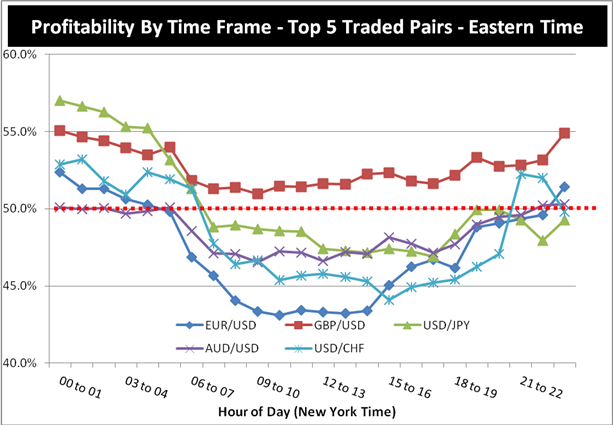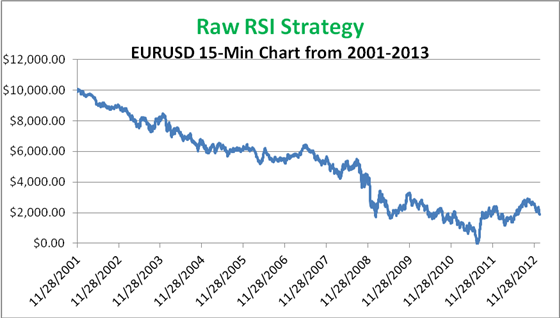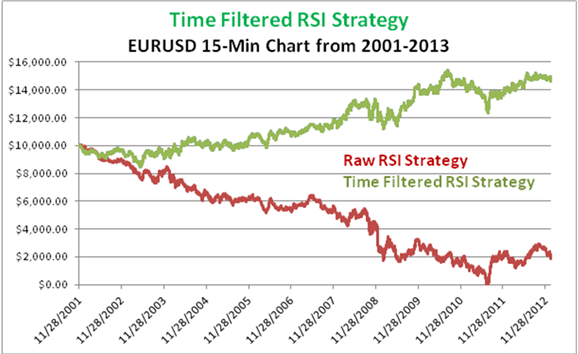Summary: For most forex traders, the best time of day to trade is the Asian trading session hours. European currency pairs such as EUR/USD show the best results.
We analyzed over 12 million real trades conducted by retail traders, and we found that trader profits and losses could vary significantly by time of day. That data showed that most traders are what are called “Range Traders,” and their successes and failures very much depend on market conditions. In fact, this trading style means that many of them have trouble being successful in forex because they are trading during the wrong time of day.
Most forex traders are more successful during the late US, Asian or early European trading sessions – essentially 2 PM to 6 AM Eastern Time (New York), which is 7 PM to 11 AM UK time.
Why? We’ve seen records for thousands of traders, and the chart below shows a noteworthy trend pulled from real trades conducted by retail traders from 2009-2010. The chart shows the profitability of traders with open positions broken down by hour of day across the five most popular currency pairs.

Those profitability statistics can certainly vary on a day-to-day basis, but the patterns are impressively stable over the course of the year. But how does time of day affect the average trader’s profitability?
You can see that periods of strong trader performance line up with low-volatility trading hours. Traders tend to see the best results during the Asian trading session, and the chart below shows that the Euro tends to move far less through this period. To see why volatility lines up so well with performance, we need to look at real trader behavior.

Range trading strategies can be summarized quite simply—buy low/sell high. If a currency has fallen and is trading at or near significant support levels, the range trader will often buy. If the same currency then trades higher and near important resistance, that same trader sells. This can work if price is not breaking major price levels and continues trading within relatively narrow ranges.
Of course that same trader would do quite poorly if price broke significantly above resistance or below support. How do we avoid the worst market conditions for this particular style of trading?
Do the Hours that I Trade Matter?
Yes, they matter a lot.
We have constructed a strategy that closely models your “typical trader”. We simulated the strategy’s performance trading the EUR/USD 24 hours a day over the past ten years. The results are not good.
Euro/Dollar RSI Range Strategy Performance, Trading 24 Hours

Trade Rules for the RSI Trading Strategy
Buy Rule: When the 14-period RSI crosses above 30, buy.
Sell Rule: When RSI crosses below 70, sell.
Yet once we factor in the time of day, things become interesting. We know that the Euro tends to move less through certain hours—let’s use that to our advantage and make a rule to trade only during low-volatility times.
This next chart shows the exact same strategy over the exact same time window, but the system does not open any trades during the most volatile time of day, 6 AM to 2 PM Eastern Time (11 AM to 7 PM London time). The difference is dramatic.
Euro/US Dollar RSI Strategy Restricted to Trade between 2:00 PM and 6:00 AM Eastern Time

Trade Rules for the RSI Asia Range Trading Strategy
Buy Rule: When the 14-period RSI crosses above 30, buy.
Sell Rule: When RSI crosses below 70, sell.
Trade Filter: Only allow the strategy to open trades before 06:00 and after 14:00 Eastern Time.
By sticking to range trading only during the hours of 2pm to 6am, the typical trader would have hypothetically been far more successful over the past 10 years than the trader who ignored the time of day.
What About Other Currency Pairs?
Of course, not all currencies act the same. For example, the Japanese Yen tends to see more volatility during Asian hours than the Euro or British Pound; these are the hours of the Japanese business day.

We simulated the same filter as we used with the Euro/US Dollar. The poor results speak for themselves.

We find that the time filters have historically worked well for European currency pairs such as the Euro/US Dollar and the US Dollar/Swiss Franc. The filters also work fairly well for the GBP/USD. We might range trade these currency pairs during the 2 PM to 6AM time window.
Unfortunately, our optimal time window does not work well for Asian currencies. Our tests of different time windows on the USD/JPY, AUD/USD, and NZD/USD have not produced a single positive equity curve over the past 10 years. This is due to the fact that these currencies are more often subject to large moves during Asia Session than the European currencies.
Game Plan: What Strategy Should I Use?
Trade European currencies during the “Off Hours” using a range trading strategy.
Our data show that over the past 10 years, many individual currency traders have been successful range trading European currency pairs during the “off hours” of 2 PM to 6 AM Eastern Time (7 PM to 11 AM UK Time).
Many traders have been very unsuccessful trading these currencies during the volatile 6 AM to 2 PM time period.
Asia-Pacific currencies can be difficult to range trade at any time of day, due to the fact that they tend to have less distinct periods of high and low volatility.
Model Strategy: Range Trading with RSI on a 15 Minute Chart
For our models, we simulated a “typical trader” using one of the most common and simple intraday range trading strategies there is, following RSI on a 15 minute chart.
Trade Rules for the RSI Asia Range Trading Strategy
Buy Rule: When the 14-period RSI crosses above 30, buy.
Sell Rule: When RSI crosses below 70, sell.
Trade Filter: Only allow the strategy to open trades before 06:00 and after 14:00 Eastern Time.
_____________________________________________________________________
The Traits of Successful Traders
This article is a part of our Traits of Successful Traders series. View the previous installment of this series:
Why do Many Forex Traders Lose Money?
The DailyFX Research team has been closely studying the trading trends of retail traders. We have gone through an enormous number of statistics and anonymized trading records in order to answer one question: “What separates successful traders from unsuccessful traders?”. We have been using this unique resource to distill some of the “best practices” that successful traders follow, such as the best time of day, appropriate use of leverage, the best currency pairs, and more.







